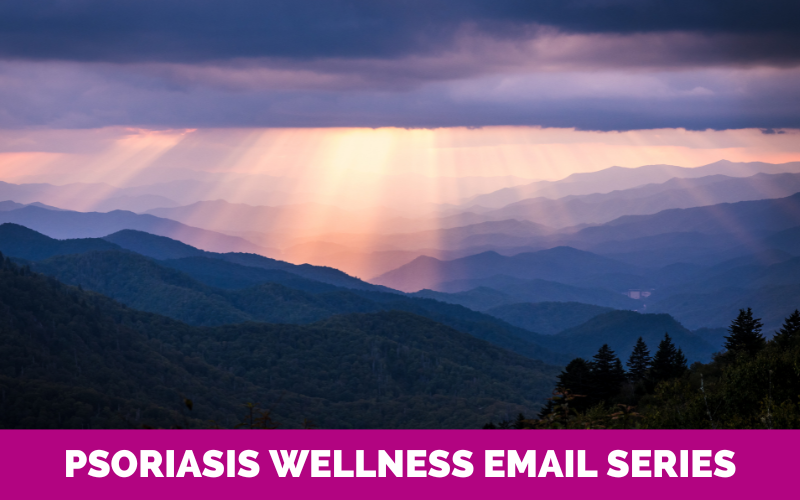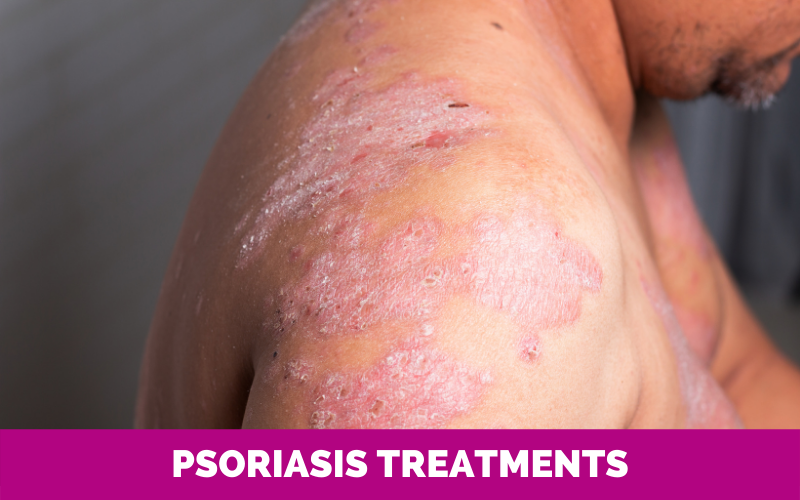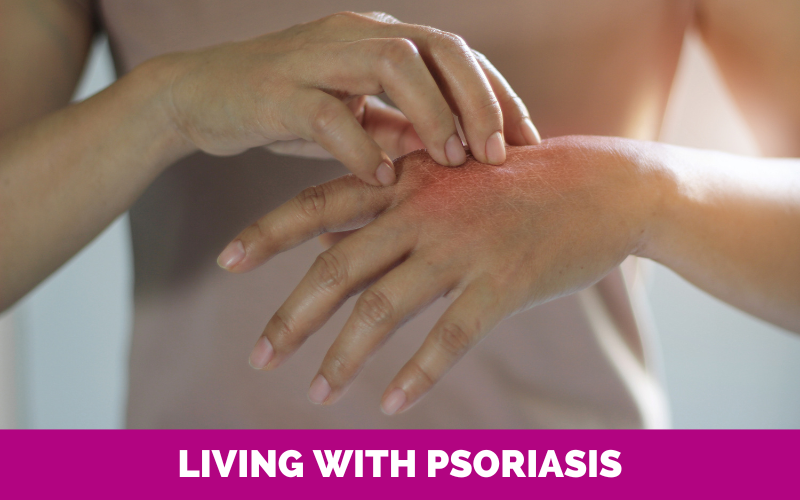Psoriasis Quick Guide
Symptoms, Treatments and Self-Management
Are you one of the 1.6 million Australians living with psoriasis? Perhaps you know someone with psoriasis and you’d like to know more about it.
Our quick guide to psoriasis is designed to provide an overview of this autoimmune skin condition, the current treatment options and the impacts on mental health.
Psoriasis is known for symptoms you see on the skin, but this condition runs deeper than that. It is an autoimmune disease that occurs when the immune system starts attacking healthy cells — usually skin cells — instead of targeting foreign bodies like bacteria and viruses.
This process causes skin cells to develop and shed rapidly in affected areas. Normal skin cells take around 28 days to grow and shed. However, skin cells affected by psoriasis can mature in just three or four days. Dead cells accumulate on the skin surface to form legions (patches).
Legions can occur on different parts of the body including the face, scalp, hands and feet, groin, skin folds and nails. They can be very dry, cracked and itchy but scratching can cause them to bleed. They vary from mild patches in a few spots to severe cases that cover most of the body.
Psoriasis affects around 1.6 million Australians. Although it can begin at any age, psoriasis is more common among adults than children and affects men and women equally.
Psoriasis can be unpredictable and frustrating for sufferers, as it comes and goes in cycles of remissions and flare-ups over a lifetime. Every person with psoriasis has their own unique set of triggers that can set off a flare or worsen symptoms. These triggers include stress, certain medications and skin injury.
There is currently no cure for psoriasis but it can be well-managed. In many cases, treatment can also reduce the size and severity of skin lesions or clear them up altogether.
It is important to know that psoriasis is not contagious. You can’t catch it by touching someone else’s skin plaques.
The exact cause of psoriasis is not known, but several factors are known to play a role.
Some people are genetically predisposed to autoimmune conditions such as psoriasis, rheumatoid arthritis or lupus. However, the specific genes (or gene combinations) associated with psoriatic disease are yet to be identified conclusively. We do know the genes related to autoimmune conditions can remain dormant in some people, skip generations or lead to different autoimmune conditions within the same family.
While autoimmune conditions can be present at birth, most can appear at any age following exposure to an internal or external trigger. Psoriasis triggers can include, but are not limited to:
- Stress
- Injury to the skin
- Infections, such as streptococcal tonsillitis or HIV
- Certain medications, such as lithium
- Cold weather
Other factors, such as smoking heavy alcohol consumption or obesity, can also increase your risk of developing psoriasis or other autoimmune conditions. Hormonal changes (such as pregnancy) can trigger flares of existing psoriasis.
Following a trigger, it is believed that T-cells, a type of white blood cell designed to fight off viral and bacterial invaders, begin to attack healthy skin cells by mistake. This process leads to an overproduction of healthy skin cells. New skin cells move to the outermost layer of skin in days rather than weeks, resulting in scaly patches of skin build-up.
In most people with psoriasis, the disease goes through cycles, flaring for a few weeks or months, then subsiding for a time.
Psoriasis symptoms can vary from person to person and depend on the kind of psoriasis you have. Some people may have a few patches near their scalp or elbow; others can have patches that cover much of their body. It is possible to have more than one form of psoriasis at the same time.
Here’s a look at the most common symptoms of psoriasis to be aware of.
Silver, scaly patches
What sets psoriasis apart from typical rashes are the thick white or silvery patches that are the classic tell-tale marker of a type of psoriasis called plaque psoriasis. These plaques usually show up on the elbows, knees and scalp, but they can appear anywhere on the body. Plaque psoriasis occurs in 90 per cent of people affected by the condition.
An itching or burning feeling on the skin
Although psoriasis patches aren’t usually irritating, some people do report itchiness. People who have psoriasis of the scalp can report it as feeling very itchy or dry. The itching and pain can interfere with basic daily activities including self-care, sleep and even walking.
Dry, cracked skin
The skin of a psoriasis patch tends to be very dry, which is why bland but powerful lotions or creams can help. Psoriasis patches on the skin can crack and bleed, which can cause pain for some patients. People with painful plaques on the hands and feet may have difficulty with exercise, performing certain occupations or doing household chores.
Small, red dots or lesions
This type of psoriasis looks very different from the silver plaques. Called guttate psoriasis, it may be set off by having a strep infection. It’s the second-most common type of psoriasis after plaque psoriasis.
Red patches of skin
This type of psoriasis is known as inverse psoriasis. These flat, red, shiny skin patches usually have well-defined edges. They usually occur in folds of the body, such as in the elbows, knees or groin.
If they occur in your armpit, you may mistake them for irritation or even an allergic reaction to your deodorant. If these red lesions occur in your groin, you might think you have jock itch or an STD.
Patches on the scalp
People with milder cases of psoriasis located only on the scalp could mistake their symptoms for dandruff. The main difference in the appearance between dandruff and psoriasis patches is that dandruff is usually white, dry flakes, whereas psoriasis patches have a red or silvery sheen. Scalp psoriasis can make the skin crack or bleed and may lead to hair loss.
Blistery pustules on the body
Pustular psoriasis is less common than plaque psoriasis, but its symptoms can come on much stronger. Larger areas of the body are affected, and instead of scaly patches, patients will have flares of pus-filled blisters. Palmar plantar psoriasis occurs on the hands and feet. Generalised pustular psoriasis is rare but can be life-threatening if not treated quickly as it affects vital functions.
Shedded layers of skin
Erythrodermic psoriasis is another rare form of the disease. Symptoms include intense redness and shedding of skin layers in large sheets. It often affects nearly the whole body and can also be life-threatening as it disrupts the body’s normal temperature and fluid balance.
Discoloured, pitted nails
Dermatologists don’t just check the skin if they suspect a patient might have signs of psoriasis — they look at the nails for yellow or red discolouration too. Nail symptoms include pitting in the nail and the nail plate lifting off the nail bed. That can cause pain if debris gets caught in the space underneath. Nail symptoms usually accompany body psoriasis, but they can develop in isolation too.
Stiff, painful joints
The autoimmune problems causing skin symptoms can also affect the joints in up to 30 per cent of people with psoriasis — a condition called psoriatic arthritis. Most people who develop psoriatic arthritis do so within five to 12 years of having psoriasis. Sometimes, people are diagnosed with both psoriasis and psoriatic arthritis at the same time. In some cases, people get joint pain symptoms before psoriasis skin plaques show up.
If you suspect you might have psoriasis, it’s important to see a dermatologist as soon as possible to get examined, diagnosed and treated. Because psoriasis is an immune system disorder, it generally won’t go away (and stay away) on its own. Effective psoriasis treatment can relieve not just symptoms, but underlying inflammation that can cause other serious problems over time.
Some psoriasis treatments are applied directly to affected areas to help shrink them and make them less dry and itchy. Others work on the immune system itself, holding it back from attacking healthy cells to stop psoriasis symptoms in their tracks.
The kind of psoriasis treatment your dermatologist recommends will depend on how serious your psoriasis symptoms are (mild, moderate or severe) and where they’re located.
The traditional approach is to start with the mildest treatments — topical creams and ultraviolet light therapy — and then progress to stronger ones only if necessary due to the side effects of these stronger options. We all respond to treatments differently so it can take trial and error to find the right mix of treatments for you.
Here’s a look at the different ways psoriasis can be treated.
Topical treatments
Emollients
Psoriasis can leave the skin feeling parched so many people find it helpful to apply a gentle emollient, such as Vaseline, to moisturise their skin. Avoid products that are overly fragrant or have a lot of additives as they could sting or aggravate symptoms.
One method called “occlusion” helps calm pain quicker than other home remedies. It involves applying moisturiser or oil to sore areas and wrapping them with plastic wrap or covering them with socks, a plastic bag, or gloves (if the soreness is in the hands or feet).
Salicylic acid
Salicylic acid, an ingredient found in certain moisturisers, encourages the skin to self-exfoliate, so it can reduce the scaliness of psoriasis by getting rid of debris and excess proteins called keratins. It may also help other medications penetrate more effectively as the tough layer of skin cells peels away.
Topical corticosteroid creams
Topical steroids don’t just ease the itchiness and pain of skin plaques; they slow skin cell turnover by suppressing the immune system. Topical steroids are useful during flare-ups but relying on them long term is generally not recommended as they may cause the skin to become thinner.
Vitamin D analogues
Vitamin D, the “sunshine vitamin” your body makes from being exposed to UV light, is important for keeping your skin healthy. Having low vitamin D levels won’t cause psoriasis, but people with psoriasis do tend to be deficient in vitamin D. Vitamin D analogues (such as calcipotriol or calcipotriol) are not the same as vitamin D supplements. Instead, they are combined with a topical corticosteroid to help slow skin cell growth and rebalance or normalise the way your immune system is responding. Vitamin D will also encourage healthier skin cells to grow.
Light therapy
UV light can suppress the immune system, however, extended exposure to sunlight is not recommended. Instead, dermatologists use machines that emit UV light with shorter (and safer) wavelengths than produced by the sun or a tanning bed. Light therapy (phototherapy) is available in Australia through dermatology clinics and is subsidised by Medicare.
Systemic treatments
Retinoids
Vitamin A derivatives called retinoids encourage old skin cells to make way for newer, healthier ones, which can help eliminate psoriasis plaques. Some retinol products can be bought over the counter, but more potent topical retinoids such as tretinoin, isotretinoin or tazarotene are only available on prescription. Retinoids are available in topical and oral forms.
Disease-modifying treatments
Disease-modifying anti-rheumatic drugs (DMARDs) work by suppressing an overactive immune system. This slows disease activity and reduces inflammation. Conventional synthetic DMARDs (such as methotrexate and cyclosporine) are made from synthetic chemical compounds with small molecules. They are also small enough to be processed through the digestive system, so they can be taken in oral form.
The risk with DMARDs is they can suppress the immune system to the point where pathogens such as viruses can take hold. Therefore, it is important for patients and their treating doctors to work together to find the immunosuppressive treatment and dose that best balances these competing priorities.
PDE4 inhibitors
This newer category of medication is considered a targeted therapy. It affects a pathway in the immune system that causes inflammation in plaque psoriasis. PDE4 inhibitors are not considered biologics but they are more targeted than traditional disease-modifying drugs like methotrexate or cyclosporine.
In Australia, people with severe chronic plaque psoriasis who cannot use methotrexate may be prescribed the PDE4 inhibitor apremilast by their dermatologist.
Biologic medications
Patients with severe psoriasis and/or psoriatic arthritis can apply for access to biologics (also called biologic DMARDs) such as adalimumab, guselkumab and infliximab. Biologics for these conditions can only be prescribed by dermatologists or rheumatologists.
These medications are developed from biologically sourced cells and have very large molecular structures compared to those of oral-form medications. (Picture a basketball next to a pea and you’ll get the idea.) As a result, biologics cannot be processed through the digestive system. Instead, they are injected or infused into the bloodstream.
Biologics are designed to act like the proteins that are already in your body. They target specific areas of your immune system and are proven to be very effective at minimising disease activity. Because they are so specific, they may cause fewer side effects than conventional synthetic DMARDs. However, like other DMARDs, they can increase your risk of infection and they may work well for some people and not others.
Psoriasis diet
No diet can cure psoriasis. Though there is little scientific evidence for a psoriasis diet, many people with psoriasis say they’ve found symptom relief from changing what they eat. Obesity is linked to an increased risk of psoriasis and can worsen the severity. Therefore, it is a good idea to maintain a healthy weight to the best of your ability.
Reducing inflammation with an anti-inflammatory diet may also be helpful. This includes eating oily fish high in omega-3s such as salmon, plenty of fruits and vegetables (particularly dark leafy greens), low-fat dairy products, nuts and nut butter.
Foods that increase inflammation should be avoided or reduced, such as partially hydrogenated oils, fatty red meats, fried foods and processed/fast foods. If you have severe psoriasis, it may be beneficial to reduce or eliminate alcohol.
People with psoriasis have an increased risk of gluten sensitivity and inflammatory bowel diseases (including Crohn’s disease and ulcerative colitis) so if you experience any digestive symptoms, it is important to be tested for these conditions.
Unlike many other autoimmune diseases, psoriasis can be very visible, especially when it occurs on the face and hands. Legions are often red, scaly and cracked or bleeding. As dead skin sheds, it can leave scatterings of dandruff-like flakes around the affected person. It is, therefore, no surprise that people with the condition can experience social stigma, poor self-esteem, depression and anxiety about forming close relationships.
It can also be hard to cope with other symptoms of autoimmune disease such as pain and fatigue. If you are struggling to deal with the mental or emotional effects of psoriasis, you can reach out for help via:
- Supportive friends or family
- Your GP
- A mental health practitioner
- A psoriasis patient organisation, such as Psoriasis Australia (facebook.com/psoriasisaust) or email [email protected].
- A psoriasis support group in your area or online.
If this content has raised feelings that concern you, visit the Lifeline website or call 13 11 14.
Helpful resources
International resources






